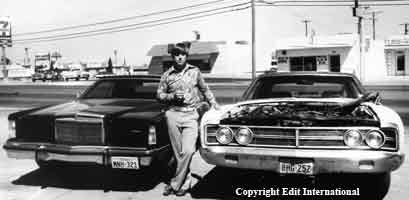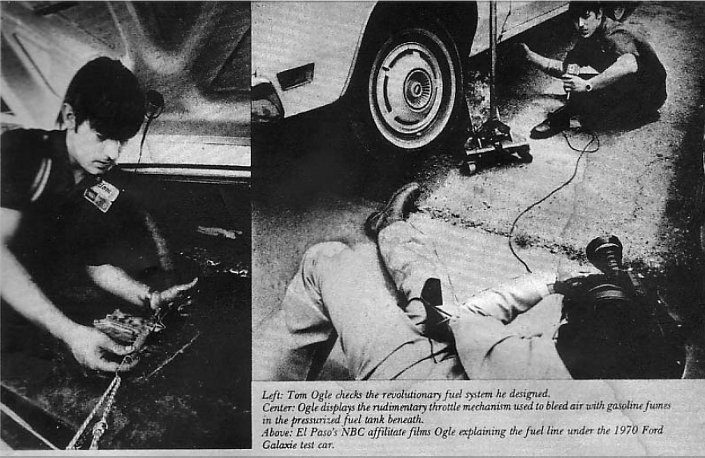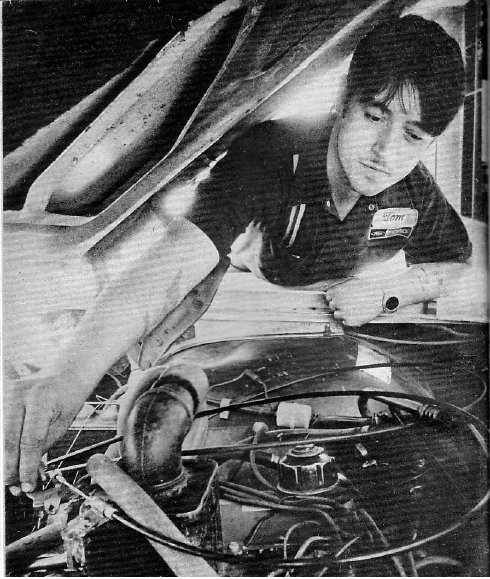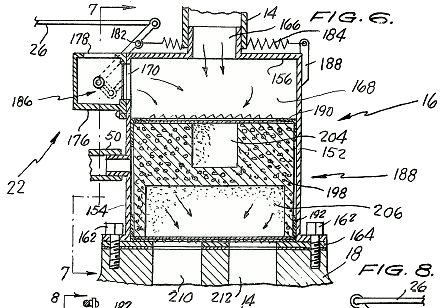updated 12-01-2014
What Ever Happened to Tom Ogle?
His super carburetor gave 100 mpg on a 427 inch v8 1970 Ford Galaxy
By Ron Laytner; Edit International; Copyright 2010
Did the world not go green because of a murder? Maybe 2 murders?

The world is telling us to Go Green; from Sesame Street to the Campaign Trail, and Going Green has become as much a marketing tool as a call for action. But what most American’s don’t know is that these problems were solved thirty years ago by the brilliant invention of a Texas high school dropout.
In 1978 I first interviewed Tom Ogle who created a device replacing the carburetor and allowed his 4,000 pound car to get 100 miles per gallon. He should have gone on to change history and become one of the world’s richest men. He was young, confident and feared nothing. But he was wrong – dead wrong. Four years later Tom, at age 24, was in his grave and his invention, buried.
***
I stood outside the Smuggler’s Inn, a restaurant in El Paso, where I’d just interviewed Tom Ogle, only 21, and perhaps one of America’s greatest inventors. He was leaning against his 1970 Ford Galaxie. Fitted with a black box ‘filter’ the big gas guzzler was getting more than 100 miles per gallon.

That’s when I told him, “Tom, I think you are one of the most important people on earth right now.” Smoking a cigarette, flashing a $1,200 watch and a 3.5 carat diamond ring, he replied confidently, “I hope so. My invention will save the world.”
“Are you afraid of oil companies or the Arabs coming after you?” I asked.
“No. Not any more. I’ve had too much publicity. If I’d kept my invention a secret I might be worrying. But there’s nothing to worry about any more.”
Tom said the 100 mpg returns he was seeing on his then standard 4,000 pound car was only the beginning of his newfound fuel efficiency. Tom felt confident that on the smaller, lighter cars, then only popular in Europe, he could get nine times as much.
That means in today’s light-weight automobiles we could be driving around getting 400 to 900 miles per gallon. And even gas guzzling Hummers and giant SUV’s Tom never lived to see might be more efficient than today’s best hybrid cars.
He did away with the carburetor and fuel pump; replacing them with a black box he called a ‘filter.’ The super mileage, he said, was due to his pressurized, vaporized fuel system that injected gasoline vapor, not liquid, directly into the engine’s firing chambers.
 The modified car was extensively tested and engineers found no evidence of fraud. In one test for the media Ogle drove his Galaxie, which unmodified got about 13 miles per gallon, 200 miles on a measured 2 gallons of gasoline. The results were so astonishing that the car was inspected for hidden fuel tanks. None were found and those who drove with him confirmed that they had never stopped to refuel.
The modified car was extensively tested and engineers found no evidence of fraud. In one test for the media Ogle drove his Galaxie, which unmodified got about 13 miles per gallon, 200 miles on a measured 2 gallons of gasoline. The results were so astonishing that the car was inspected for hidden fuel tanks. None were found and those who drove with him confirmed that they had never stopped to refuel.
Doubters became believers. Scientists were convinced his invention, dubbed the ‘Oglemobile,’ would soon reach world markets and earn millions.
Tom Ogle was checked out by corporate engineers and the US government who were astounded to discover the invention actually worked.
At the time I had talked with the late Senator Gaylord Nelson (Dem. Wis.) a long time contact of mine and a pioneer for U.S. fuel economy standards, about what this could mean for all of us.
“The potential benefits are too great for it to be ignored.” said the Senator and had asked the US Department of Transportation to make a thorough investigation of Ogle’s system but was met with a wait and see response from officials.
Another big supporter of Ogle’s invention was Professor Gerald Hawkins of Texas A&M University, holder of a doctorate in mechanical engineering with a background in gas dynamics and aerospace study.
“This is no hoax,” said Dr. Hawkins, “Ogle eliminated the carburetor and achieved what the gasoline internal combustion engine was supposed to do all along – to operate off fumes.
For most of the world, the name Tom Ogle has never been heard or at least long forgotten. But, thirty years later can I still hear Tom’s voice from our recorded interviews promising the world better future.
It all started with a lawn mower
During our interview the eager young inventor revealed how he had discovered his fuel efficient system by accident; “I was messing around with a lawn-mower when I accidentally knocked a hole in its fuel tank. I put a vacuum line running from the tank straight into the carburetor inlet. I just let it run and it kept running and running but the fuel level stayed the same. I got excited. The lawn-mower was running without a carburetor and getting tremendous efficiency.”
The engine got so hot Ogle used a fan to cool it and was amazed when it ran 96 hours on the fuel remaining in the mower’s small tank.
He went from the lawn-mower to the automobile, converting a car in the same manner. Its engine started immediately, but the gas tank collapsed inwards. It took months of reinforcing gas tanks before he solved the vacuum problem.
But the car, without its carburetor and fuel pump, still had no acceleration. It couldn’t run faster than 20 mph. And the modified engine averaged only 8 miles to the gallon, and stalled after a few miles.
One time he crawled under the stalled car to examine its gas tank and found, “It was freezing cold, like an ice-cube. As I was sucking vapor out, it was acting like a refrigerator with liquid on the bottom and fumes on top.”
When he warmed the gas tank with heater coils, the miles per gallon sky-rocketed to over 100 and Tom Ogle never looked back.
He believed his system was the answer to the world’s pollution problems and demonstrated virtually zero pollutant emissions coming from his engine exhaust.
Soon Tom found himself courted by oil companies and financiers. Everyone predicted he would become a billionaire.
A few months before I had met him he was contacted by C.F. Ramsey an ‘international financier’ who wanted to buy Tom’s patent and the marketing rights to the Oglemobile.
Ramsey told me by phone, “We signed a preliminary agreement with Tom Ogle the very next day after we saw the invention. All kinds of people were in town, J.C. Penny, Transamerica, General Motors, Ford and others. Specifically Shell Oil offered Tom $25 million. Everybody was after him.”
But in every case the proposed backers wanted controlling interest in Tom’s patent. They wanted to stick Tom off in a laboratory. And that would have been the end of Tom Ogle and his fuel efficient system.
And it was. That is exactly what happened.
Ramsey signed a contract which let Ogle work on his device with financing from Ramsey who would take over the patent, distribution and development rights of the Oglemobile.
With thousands flowing in, the confident Tom Ogle I had met was quickly building the life of luxury and extravagance.
A few months after my first interview, his backer C.F. Ramsey sold out to Advance Fuel Systems Inc. in June of 1978. [a pre-planned hand-off] Tom was a bit nervous in my later phone calls, but all seemed to be well. He would continue receiving $5,000 a month and funds for research and development. He’d also get 6 percent royalties when the device came to market. Advance Fuel’s own engineers would develop the ‘Oglemobile’ for marketing and in April 1979, a still very ambitious Tom Ogle opened the first of a planned 1,000 nation-wide diagnostic car centers.
But Ogle’s first and only car center soon closed and his monthly checks stopped. Ogle was told he’d get no royalties because AFS was working on a device that got similar results but wasn’t his invention.
Shot and Poisoned
Continuing in his spiraling downfall from quick success and media attention in 1981, Monica, Tom’s wife left him and took along their five-year-old daughter Sherry. Then on April 14th he was shot in the street by someone who ‘got away’ yet he survived the incident.
On August 18th a broken and forgotten Tom Ogle, drunk, left The Smuggler’s Inn, the same place that I’d first met him. That night he went to a friend’s apartment and collapsed.
He was declared dead at El Paso’s Eastwood Hospital. His death, which involved a combination of Darvon, a prescribed pain killer, and alcohol, was ruled accidental or suicide. Many believed it was a cover-up for murder.
“Ogle had been gravitating toward gambling at the pool table, and began losing a lot of money in his gambling forays. He indicated to his attorney, Bobby Perel, that he believed people were drugging his drinks. Perel was skeptical, but on August 19, 1981, Ogle collapsed and died from what an autopsy showed was an overdose of Darvon and alcohol. The death was ruled to be a suicide after a cursory investigation, but several people close to Ogle indicated that they did not believe that Ogle would or could kill himself.”
From: www.automotiveforums.com/t130379-discuss200mpg_carburetor_conspiracy_.html

difficult to put out
Postscript
In 1989 another American inventor, Stanley Allen Meyer, claimed to have invented a means by which a car could be fueled solely by water. He alleged that he had created a dune buggy which could travel across the United States on twenty-two gallons of water. He died in 1998 while celebrating the success of his invention with his brother and two financial backers from Belgium. Although his cause of death was stated as having been a brain aneurysm, many have speculated that he was poisoned so that the news of his invention would not spread and decrease the need for foreign oil. At the time of his death, Stanley Meyer had twenty patents on many water-fueled inventions.
The End
By Ron Laytner
Copyright 2010
Edit International
“Ogle Fuel System”
By Gregory Jones
He insists there were no hidden fuel tanks or other alternate fuel sources used to power a two-ton automobile for 205 miles Saturday on only two gallons of gasoline fumes.

Ogle isn’t alone, others verify his work.
Carl Wright, for example, has been working on internal combustion machines for 35 years. He is a certified teacher of auto mechanics and is currently shop foreman at Peck’s Automotive Service, where Ogle built his controversial energy-saving fuel efficient system.
“It’s no hoax.” Wright said in straight-forward fashion. “There were no hidden tanks.” Wright, who has no vested interests in the invention, said at first he was skeptical of the young man’s invention.
“I’ve watched the thing from the time they built the fuel tank to the very present,” Wright said, “It looks to me like it’ll do what Tom said it would do.”
Wright said any secret fuel compartments would have required many extra man-hours by Ogle to install in the car body.
“He only worked on the car during office hours,” Wright said,”and he didn’t have a key to the door” to get into the automotive shop during off-hours or weekends.
Experts Probe Ogle Fuel efficiency System

“He has not been here working on the car at nights, and the car has been locked up here every night.” Wright said.
James Peck, who owns Peck’s Automotive, has a 50-50 partnership on any royalties from the invention. And he said he would stake his 30 year professional reputation in northeast EI Paso on the fact that there was no hoax involved in Saturday’s test drive.
“I personally believe he (Ogle) had some help some-where along the way developing the system, although he will not admit to that. But I can vouch that the system works. It’s no hoax. It was my car he converted. We built system in my shop. I’ll put my name on the line. It definitely works.
Peck said he provided financial back for Ogle’s invention after he and Ogle met about a month ago and discussed the system.
Frank Haynes Jr. is registered state engineer with degrees from the University of Texas at Austin and Southern Methodist University. He was at Peck’s Automotive Saturday where he looked the system over and talked with Ogle.
“From what I saw, there was no hoax.” Haynes said, adding that he learned of Ogle’s invention in The Times.
” I decided to venture out and see what was going on,” he said. ” I’d never even heard of Tom Ogle before. But I’m familiar with combustion from previous work and wondered what the kid had come up with.
“What I saw was very convincing,” Haynes said. Haynes said he felt the only chance of a hoax might have been in the amount of fuel that actually was in the tank.
Prior to the test drive Saturday, reporters and onlookers witnessed a mechanic at Peck’s empty the special, pressurized gas tanks, and pour two gallons of fuel into the tank after it was empty.
Haynes said he was additionally convinced of the system’s authenticity by the fact it was difficult to start the car before heading to Deming.
“The car had to be primed quite thoroughly in order to run. That gave me the idea that there weren’t any fumes in the system after drainage.
“That was quite convincing for me personally. If there had been hidden fuel, there wouldn’t have been any difficulty in starting the car, according to how he (Ogle) described the system to me,” Haynes said.
Haynes described Ogle as an “open, earnest young man who convinced me everything he said should be true.”
Ogle all along has maintained nothing but simple trust in his invention.
“It works,” he said frankly. “There is no hoax.”
He described his Saturday test drive, in which a times reporter participated as a “beautiful performance.”
Ogle added with a chuckle that the return to El Paso from Deming was made with one pint and two ounces of fuel left in the fuel tank.
“We did pretty good though. We made 205 miles on less than two gallons,” he added.
He said he maintained constant 55 to 60 mile per hour speeds.
1979 U.S. Patent number #4,177,779 “Fuel Economy System for an Internal Combustion Engine”
“200 Miles On Two Gallons Of Gas”
El Paso Times (Texas) Sunday, May 1, 1977
By John Doussard

“Once I get to Deming and back I’ll have everybody banging at my door!” Tom Ogle exclaimed. It was as uncommon sentiment that may very well prove to be true.
Saturday the 34-year-old inventor mechanic climbed behind the wheel of his 1979 1970 Ford Galaxy and headed down the road toward both the dusty New Mexico town and possible fame, fortune and a solution to the energy crisis.

With only two gallons of gasoline in the tank, Ogle offered strong evidence that the tangle of red hoses and tubes racing between the back of the 5,000 pound car and the engine performed as billed: delivering over 100 miles to the gallon while averaging close to 60 miles per hour.
Indeed, in a day of automotive and personal triumph, the only sour note was sounded when Ogle failed to bring his gas-saver back into El Paso as planned. On the outskirts of town, just a few miles from his final goal, a rock struck the underside of the car,puncturing a filter and allowing the gas fumes the auto travels to escape.
But it really hardly mattered at that point. Ogle had traveled 205 miles on slightly less than two gallons of gas.Some of the precious liquid had been spilled when first poured in the tank.
“I use about four gallons of gas every two weeks,” Ogle said. “But then I drive an awful lot.”
Actually, Saturday’s performance was rather modest. Ogle claims his system will average about 160 miles per gallon in city driving, treatment average of 12 miles per gallon.
“I fixed-up my car, a 1972 Thunderbird with a 429 cubic inch engine, with the system,” Ogle said. “I then took it to Cloudcroft and back on two gallons, about 200 miles.
“And I still had enough to drive around when I got back in town.”
The odd thing about Ogle’s system is that doesn’t add complex gadgets and intricate gimmicks. Instead, it removes the carburetor, a piece of the engine long considered sacred.
“Engineers said it wouldn’t work because without a carburetor there’s nothing to vaporize the fuel,” Ogle explained during the trip across the hot dessert. “They couldn’t understand that it’s already working on vapors.
“Instead everybody kept trying to add something to the carburetor while nobody thought of taking the thing off.”
Basically the system uses a standard engine with a few modifications In lieu of the carburetor there is a series of hoses feeding a mixture of gas vapors and air directly into the engine.
Gas in the tank passes through a series of filters, which stretch the energy available in each gallon. The ??? also store excess vapors for later use for up to 45 days. Premium gas is needed, as its higher octane level allows for more vapors to build.
Not only does Ogle’s car promise more miles per gallon, but he says it will clean the environment while causing its owner fewer repair headaches.
“It will top anything on the road today, being smoother, better running and more efficient,” Ogle said. “The life of your car will be two times longer because there will be no carbon build-up.
“The carbon comes from unburned gas, but we burn it all.You won’t have need all the catalytic converters for the air.”
Before the journey began, two Times reporters looked the car over for possible hidden sources of fuel, and found none. Then a brief ceremony emptying the gas tank, and after the last drop fell, two gallons were poured back in.
While only an expert could say for sure the trip was completed with only those two gallons, spectators, reporters and other interested inventors present all appeared satisfied.
“This is the hottest thing of this century,” Frank Haynes, Jr. an independent engineer living in this area, said. “Engineers have been beating their heads against the wall to come up with something like this.
“I honestly don’t think it’s a hoax.”
Mileage Astounds Experts
The Tribune (June 8, 1978) By Ron Laytner
El Paso, Texas — Is a young high school dropout the most important American inventor since Thomas Edison?

The Philadelphia Inquirer believed Ogle was perhaps the greatest inventor since Thomas Edison and predicted the world would be hearing a lot about him. – Photo by Ron Laytner, Edit International
Will he and the world energy shortage and show us how to drive from New York to Los Angeles on $15 worth of gasoline? Or is it all a hoax to get inventors’ money and infuriate the oil companies?
El Paso has been excited ever since 25-year-old Tom Ogle, a simply-educated, home-town auto mechanic, astounded engineers by converting his car’s engine so it appears to drive 100 miles on a gallon of gasoline.
Ogle did away with the carburetor and fuel pump, replacing them with a secret black box he calls a filter. The super mileage, he said, was due to his pressurized, vaporized fuel system that injects fumes directly into the engine’s firing chambers.
Engineers have tried but found no evidence of fraud. On April 30 last year (1977) Ogle drove a 1970 Ford Galaxy 200 miles from El Paso to Deming, NM, on a measured two gallons of gasoline. The auto was inspected for hidden fuel tanks but none were found.
Ogle and his car were under observation at all times yet the “Oglemobile” went the distance without stopping for fuel and averaged 100 miles per gallon at 55 mph. Doubters became believers. Scientists were amazed. Many were convinced Ogle’s claim is legitimate.
Tom Ogle believes his new company, Ogle Fuel Systems, will soon become one of America’s largest corporations because the world must have his invention. He plans to have a miniaturized version installed in test cars by the end of July, and expects to have it on the market within a year, selling for about $300 a unit, installed.
If he can survive criticism by giant auto and oil interests he could become one of the worlds richest men. And he will, according to millionaire C.F. Ramsey, an international financier from Longview, WA, who has backed Ogle with “unlimited funds” for world-wide marketing rights.
Ogle was easier to meet with a few months ago but with success he’s become reclusive, a junior Howard Hughes hiding from the press.
Then, he was set up in the back of garages owned by friends. Now, he is incommunicado, headquartered in El Paso’s most prestigious building and travelling in chauffeur-driven limousines and corporate jets.
Before he went underground, Ogle told me, “We’ve had inquiries from Ford, Chevron, Shell, Volkswagen and Chrysler and calls from the biggest retailers in the world wanting marketing rights.” But company spokesman denied contact.
Ogle said he refused one man,”Said he was the chief engineer for Shell oil and asked what I’d do if I got an offer of $25 million to sell out.” Shell denies it.
But a spokesman for investor Ramsey, said many giant corporations had been in El Paso trying to buy up control of Ogle’s invention.
The inventor said he discovered his fuel efficient system by accident, “I was messing around with a gasoline lawn mower when I accidentally knocked a hole in its fuel tank. I put a vacuum line running from the tank straight into the carburetor inlet. “The lawn mower kept running.
“I just let it run and it kept running but the fuel stayed the same. I got excited. The lawn mower engine was running without a carburetor and getting tremendous efficiency.”The engine got hot so Ogle used an electric fan to cool it and was amazed when it ran 96 hours on the fuel remaining in the mower’s small tank.
He went from the lawn mower to the automobile engine, converting a car in the same manner, its engine started immediately but the gas tank collapsed inward. Many months and reinforced gas tanks later, he solved the vacuum problem.
But, the car without its carburetor and fuel pump, had no acceleration. It couldn’t run faster than 20 mph. And the modified engine averaged only eight miles to the gallon and stalled after 10 miles.
One day Ogle crawled under the stalled car to examine its gas tank and got a surprise;”It was freezing cold, like an ice-cube.As I was sucking vapors out, it was acting like a refrigerator with liquid on the bottom and fumes on top.”
When he solved the stalling problem by warming the gas tank with heater coils, the miles pre gallon skyrocketed to over 100. Tom Ogle hasn’t looked back since.
He believes his system is the answer to the world’s pollution problems and has demonstrated virtually zero pollutant emissions coming from his engine exhaust at computerized auto engine test centers.
In a typical test, with the engine running and the speedometer over 55 mph, a jet of clean hot air, without the usual obnoxious smell, leaves the Oglemobile’s exhaust pipe.”You can dry your hair with it,” said Tom Ogle.
After an hours high-speed run, water in the radiator is only luke warm. And a spark plug installed before the test comes out cleaner than it had gone in.
He isn’t afraid of oil interests.”My wife Monika is scared, afraid I’ll get kidnapped. But I’m safe. People still can’t believe or understand what I’ve discovered.
Ogle said he asked President Carter’s assistance with developing his invention and had sent the president all the data and test results on his experimental model. At one point an official with the U.S. Energy Research and development Administration declared Ogle’s vaporized fuel system contained no fakery.
“I think personally, and with strong conviction, that there is no hoax,” said Richard W. Hern, fuel engineer systems supervisor at ERDA’s research centers at Bartlesville, Okla. on May 6, 1977, after examining Ogle’s invention until his patent and other legal matters were settled.
But later Hern said it was impossible to get such mileage as the invention promised. He couldn’t say more, he declared, because he was bound by a statement of confidentiality he signed so that he could view the invention.
Ogle’s noisiest critic has been Robert Levy, an El Paso physicist who insisted it was impossible to move a 5,000 pound car more than 50 miles with the energy contained in one gallon of gasoline. Levy had stated the Oglemobile was a fraud but lately, as Ogle’s credibility grows, he has backed off, denying he ever called the system a hoax.
Mack Massey, an El Paso auto dealer, who claims he’s an early Ogle backer, said a patent search made last year on Ogle’s system turned up a similar General Motors patent approved in 1972. But GM spokesmen said the company had more than 500 patents granted that year and would need a patent number to find out which invention Massey spoke of.Ogle said he received a phone call from GM requesting permission to inspect the car. But Joe Karshner, a company spokesmen, said “We haven’t approached Ogle. He has never made a submission to us and we’ve never gone to him.
“This is very controversial. We are interested in anything and everything that would improve a vehicle’s performance. If Ogle’s invention is legitimate we would be interested. He is free to come to us.”
Highly qualified men praise Ogle’s system: John Whitacre, professor of mechanical engineering at the University of Texas, El Paso, said, “To me it looks like the only thing leaving the tank is air vapors, giving better combustion. It’s a different approach working with gas already vaporized.”
Another supporter is professor Gerald Hawkins of Texas A&M University, holder of a doctorate in mechanical engineering with a background in gas dynamics and aerospace study, member of the American Institute Of Aeronautics and Astronautics and The American Society of Mechanical Engineers.
There is no hoax eliminated the carburetor and achieved what the gasoline internal combustion engine was supposed to do all along-to operate off fumes. I don’t know why somebody didn’t try this before.”
Another Texas inventor, Frank Read of Fort Worth, said he perfected a system to improve gas mileage and that fights with auto manufacturers almost broke him. He said he underwent 11 court battles with oil companies trying to buy of his unit with an agreement he never build another. He felt Ogle had a long, hard road ahead.
In Washington a spokesmen for U.S. Sen. Gaylord Nelson (D.Wis.) said, “It sounds to good to be true.But if the Ogle invention proves feasible, results would be awesome.
“America could become oil self-sufficient and the drain of oil dollars to the Middle East ended.” said Jeffrey Neddleman, legislative assistant to the lawmakers who pioneered U.S. government fuel economy standards.
“The potential benefits are too great for it to be ignored. The senator is asking the Department of Transportation to make a thorough investigation of the Ogle system.”
Argosy magazine
The August 1977 issue of Argosy magazine which carried a five-page article on the Ogle mobile has disappeared from many libraries and even the Library of Congress. Argosy even ceased publication shortly after the article published. The El Paso NBC TV station which had filmed the test run “lost” the footage.
http://www.criticalunity.org/news/energy/283-history-of-new-energy-invention-suppression-cases
next: Ogle in Argosy magazine
Today
For detailed instructions on how to get 200-to-400 mpg fuel efficiency (run your car on fumes) see our page
Run your car on vapors

the T fitting: 1-1/2 inch diam. = $3
1-1/2 inch diam. vinyl tubing = $3/ft
from your hardware store
Run Your Car On Vapors
Car gets 400+ MPG John Weston
Super Carburetors
Charles Pogue Carb.
Ogle in Argosy mag.
A Hydrogen Generator You Can Build







Save this planet, expose the secret. Please.
Isaias Ochoa
I built one of these back in 1979 a little after Ogle built his. I was working at Ryder truck rental in Dallas, Tx at the time. I had been working on my proto type based on the Pogue carburetor. I was running my proto type on an International Scout II 1977. I was getting about 105 mpg at one time. I had gone to a few places to find out about marketing it. I was then told that Ogle was not able to sell his because of the one that General motors already had a patient on. Mine did not come close to theirs, so in order to get a patient you would have to come up with a different Idea. This is what Ogle had already done. He changed all of it to a totally different design. In the Pogue carburetor the fuel was sprayed into a small chamber through 2 injectors to create the vapors and recycled the fuel not vaporized. Only allowing fresh fuel in when the chamber got low. Fuel vapors were cycled through a drying chamber heated by hot water from the engine. Droplet fell back into the chamber to be recycled. The Dry Vapors were pressurized to 5 psi and recycled until used in a small chamber so you could get the burst of vapor on acceleration. This system was very similar to a LP gas vapor system. I used some parts of one on my prototype. After he died I felt that the oil companies and the US government with their billions of taxes per gallon of gas, that anyone trying to sell this devise would not be around long, so I stopped. The same as the guy that created the hydrogen converter that ran a regular car on water. It only converted as much hydrogen as needed from the water and the governments still want the taxes. So they pulled the converter out of the system and put a hydrogen bomb (so to speak) under the car as a fuel tank. This way they could this sell you the hydrogen, not water. When the government finally gets the tax system out where they are charging you by the mile and not by the gallon then we might see other technology released unless the oil companies take over and say, no we still want our billions.
I dont know if it has been mentioned but for any who are doing experiments in “Improving MPG of Gasoline” or anything that uses an o2 sensor, you should switch to a carbureted or any mechanically controlled fuel metering system. Any fuel injection system utilizing o2 sensors or the like operate on an “Acceptable Amount of Waste” principle. Basically they measure the amount of oxygen/fuel vapor ratio and maintain what is programmed to be optimum mixture, if it sense to much oxygen it adjusts the mixture to be more rich, and too little it leans out the mixture. So that it maintains what is viewed as acceptable by the manufacturers and their board members. So if you make the vehicle burn cleaner, it will dump in more gas, potentially making your tests when successfully burning better to actually decrease mpg. So for this type of testing, it is a flawed platform for comparison.
the only thing going into the fuel injector rail is fumes.
Hi. Here is a easy way to improve mpg in EFI engine. Put a belt heater around the fuel-filter and similar heater spiral around the last bit of fuel pipe to injectors so you get about 100-120 degrees C. You must have connected a pc to engine OBD and check the sensors get errors and change the value on them.
Regards from Sweden and by the way the jet engine vaporizes their fuel, just think on the fighter jet’s around 80,000 hp and no fuel tank?
?
I wanted to stop n say on here that anybody who believes in or is interested in developing this type of technology testing trial and error i am interested as well so i do believe if we collaborate we can accomplish this goal that tom ogle already did and quite possibly even more who knows his time was limited but he was a genius. I truly believe we as a concerned people of humanity can figure this out. Please respond if you are anywhere close to me so we can work together until then i will be posting my own trials and errors as i try to move us forward as we should be.
This is the best place to share information. Please do so.
– ed.
Sadly, much of the world is about “making money / maximizing profits” … my father makes his own bio-diesel from his own formula, has been for 6+ years; runs in his furnace too, burns clean, amazing, really. My parents also burn wood, efficiently, my father built a “solar kiln” which he uses to “season” the wood as burning wet wood creates more creosote and it takes a lot of energy to boil the water out of the wood. He built his home in 1981. It does not face the road, it faces the sun, approx. 5 degrees west of southwest. People are afraid to appear vulnerable, though we all are. People are insecure and self-absorbed and they remain silent, afraid to lose their iPods or SUVs and unfortunately, that enables corruption to fester. The oil companies are interested in making money and nothing else, sadly. Again, record profits is just not enough for them, their gluttony, brought on by their insecurities, drives them to make more and more money. Their interest does not lie in making our planet a better home, it lies in making more money, at the expense of the demise of the planet. Corporations are out to make money. Walgreens, Walmart, etc., these companies spread their stores into as many towns as possible, yet none put an array of solar panels on top of their buildings. It should be mandatory, really. Things need to change, but unfortunately, until honest, caring people make it into “power” and work for the people, the rampant corruption, driven by the monetary gain, will not cease.
I have faith, I can see it coming, hopefully sooner than later. I’m not sad I do not have children, nearly glad, as I’d have a hard time trying to get them to understand why people are mostly out for themselves and why we, the human race, are so smart, yet we continue to ignore reality and do harm to our planet, ourselves and others, in the name of money. We can slap a comet moving at 17,000+mph, with a garbage can sized probe, yet every home built today is not as efficient as could be.
Great site by the way, I’ll get back to you before long as I’m going to be revamping my sites soon and links are important.
-Dave Watkins aka Mistokus
estimate:
Please if you can send me information for testing in my 8-cylinder engine.
hope response
Pedro
I’m an el pasoan born and raised in el paso texas… I have a team of mechanics that are willing to duplicate the olgemobile system… open shop and install the system to all interested people… and if the people in black want to visit the shop we will be more than ready for all haters.. we’re not 21 years old and well connected..
I have known about Tom Ogle and wondered myself why no person has duplicated this feat. There must be a million mechanics out there that could easily create the same mileage per gallon 40 years later. I also remember the electric cars GM made were destroyed even after a group of organizers offered them full retail price for all of the ones left in inventory.The oil companies cannot profit and control us without waste!
There are multiple patents that can accomplish similar MPG (even better) but why would the oil companies want this type of technology to surface? Oil companies and car companies are in this together (along with the government). They will continue to close down innovation that improves MPG until they are in a position to own the market on hybrid and electric car technology. Tom Ogle was murdered by Shell Oil.
I agree with Christine. Why has no one, a mechanic or engineer or a regular someone came up with or a similar invention. It’s funny how everyone uses youtube to make very stupid videos and the get world acclaim. Yet no one is trying make something people say are some what easy to make and post a video.. Christine, I say the same thing. WTF are we doing…nothing is the answer. Because everyone is complaining and not doing..
There are a number of people “doing it”. See our Super Carburetor page and also read about John Weston for, perhaps, the most recent success story to make the news. Still, Christine is correct, a few more people commenting here should get started on it and tell about it.
-ed
How much evidence does there need to be that the government and big business operate with a hidden agenda? Think about how much money the government makes from the automobile, from the sale of a car, to the maintenance and insurance and the regular requirement of gas and oil, and the eventual replacement of the vehicle in 6-10 years. Government depends on the automobile and relies on motorist fees and traffic violations for money to survive. Why would they want to eliminate the majority of residual income that’s associated with this purchase?
OK…..lets get all you grease Monkeys together and build one.
This kid did it way back when with lots less technology !
Use this blog as a portal and or think tank…WTF are we waiting on !!??
I lived in El Paso from 77-85. I talked with Ogle via phone concerning work he did on my Toyota Land Rover. The vehicle had a problem with the fuel system. I got the feeling from him that fixing cars and small engines was no big deal for him (he was confident, not cocky). I remember him as very easy to talk to and pleasant. His shop was 5 miles from my residence. He told me that he ran a lawn mower for 24 hours, continuously and the tank was still nearly full the next day. I blew this off as just talk and dismissed it.
Is this system designed and built by Mr. Ogle available on the market? Can any mechanic add it to my vehicle? (2006 Ford Freestar van) If I buy a new car or van can I remove it from the vehicle I drive and put it on my new vehicle? Where can it be purchased? How much does it cost? Thank you. Mike
If you did not read that he sold his system and soon “Ogle was told he’d get no royalties …”, development on it was terminated for a similar device “that wasn’t his invention” [a lie, obviously, since there was no “similar” device]
. . . it seems like you did not read the article.
Hi,
I live in Indonesia where a local guy is marketing a dirt cheap add-on that will fit any motor vehicle. It’s called the Hydrocarbon Cracking System (HCS) and works by super-heating gasoline vapour in a narrow-gauge copper tube wrapped around the hottest part of the exhaust pipe. The vapour gets cracked by heat alone into Hydrogen and Carbon which is drawn into the vacuum intake of the engine. The result is a 40% to 90% mileage increase. The vapour is created by simply drawing fresh air through a bubbler tank with regular gasoline in it.
I contribute to a thread on the subject at the Fuel Saver forum: fuel-saver.org/Thread-Hydrocarbon-cracking-System
It’s not a super-carburetor but a cheap add-on to any regular motor vehicle which can be put together for a couple of bucks in an afternoon in any domestic garage. All my vehicles use this system and achieve greatly improved efficiency which is noticeable in the smooth, quiet run to the engine, increased power and MPG. There are also no obvious exhaust emissions with what appears to be just steam coming out of the tail-pipe.
This system is ripe for improvement too.
Dan.
PS
HCS works best when the cracked vapours are drawn into the engine via a Venturi vacuum (which increases with the speed of the engine of course).
Many vehicles don’t have a Venturi vacuum inlet and it is a little difficult to fit one.
More easily fitted is a Manifold vacuum (just drill a small hole in the inlet manifold and insert a metal pipe) but the suction is greatest at idle and actually decreases as the engine speed increases.
To fix this problem; a spur pipe can be taken off the exhaust pipe just before the muffler and the exhaust gases fed to the bubbler tank inlet.
At idle; there is low exhaust pressure which increases as the engine speeds up.
This makes it an ideal ‘passive’ system for pushing the fuel vapours through the Hydrocarbon Cracking System and into the Manifold intake.
The warm exhaust gases aid fuel vapourization and also contain ‘expansion mediums’ which increase the efficiency of the power stroke in the engine cycle.
The lack of oxygen in the vapour line also increases the safety factor of the system as neither gasoline nor hydrogen will burn without oxygen.
I’m running this system on a Honda 200cc motorcycle with very good effect.
On the subject of ‘suppression by murder’, this system is well beyond suppression as nobody has ever tried to patent it.
From the outset; it was offered freely on open forums and is now firmly in the public domain; installed on hundreds of vehicles in Indonesia and elsewhere.
No black box, no secret components and so simple that everyone who has installed it understands exactly how it works.
All the best.
Good luck and keep us posted!
-ed.
My dad and I tried to duplicate the device o a 1972 ford v-8. We used hot water from the engine to heat the fuel tank with an air bleed on the tank and a large hose carrying vapor to the engine with another throttle plate there. We tried charcoal as a filter at the engine to remove large droplets of gas. Yes it ran and could be driven on the street but once all the lighter elements of the gas were evaporated the fuel became thicker and fresh gas had to be added. Fuel consumption was very poor. Eventually we reinstalled the carb and sold the test car.
Gary
You have come up with your own design … that doesn’t work. Study those who succeeded.
-ed
Cebeco Pty Ltd
Process Engineering Suppliers
cebeco.com.au
… currently own the patent (US 4177779) on the Ogle system.
if you build it, they will destroy or kill you !
Don’t jump to conclusions. They have not all been killed. Some were just tricked and bought out.
most notably, Denny Klein, Daniel Dingel, and John Weston are still around. Also, see Tesla Motors, all electric and goes 250 to 300 miles on a charge. Makes both the Volt and Leaf look like half-hearted non-efforts. They are being ignored by big oil. That could be a big oil mistake. Already, Bob Lutz, at GM, has “turned around” because of them. Batteries are getting smaller and Nikola Tesla, who was killed because of what he knew, knew how to get AC coming from space, any where, any time; no batteries needed. See the page “Tesla’s Electric Car” and other pages.
“Electrical power is everywhere present in unlimited quantities and can drive the world’s machinery without the need for coal, oil or gas…” – Nikola Tesla, 1892
– ed
I would like more info on the details of the Ogle system if it is available. I’m under the opinion this needs to be a grass roots movement. Info passed from one motivated person to the other. Thanks
Yes, if it is something simple enough that anyone can build it, lately, John Weston seems to have succeeded.